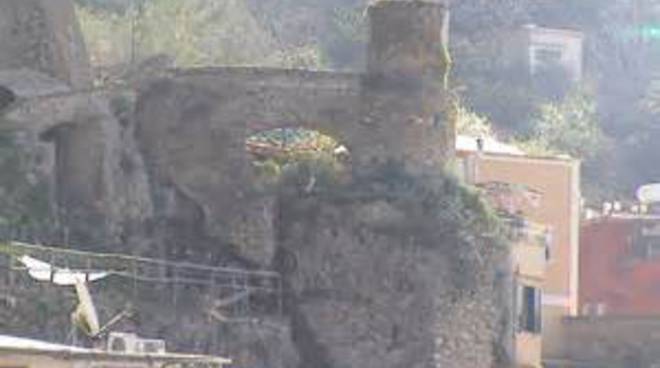Discovering Positano. Quella contrada popolata da Sirene, ippocampi e … muli. VIDEO
Più informazioni su

Oggi, 2 marzo, Discovering, dopo degli esordi impostati su di un razionalismo impregnato da un alone storicistico, almeno per una volta si diverte a sognare con i suoi lettori un incanto della Positano romana, lasciando anche un po’ di spazio all’apertura mentale, immedesimandoci nella realtà dell’epoca.
Tutto nasce da un racconto di mia nonna Cinque Assunta, a cui inizialmente non davo tanta importanza (era il periodo dei miei studi in Lettere con la tesi sulla Positano medievale, che, tra l’atro, si trova nella Biblioteca Comunale), essendomi basato sulle testimonianze suggeritemi dai professori universitari. Siamo a cavallo degli anni ’40 e ’50 del 1900, mia nonna prestava servizio nella villa di Arienzo di Michail Semenov ed, allora, ebbe modo di vedere conversare proprio il mitico scrittore russo con personaggi del calibro di Picasso, Braque o Zagouriko, solo questo mi fa venire i brividi. Ogni volta che lo venivano a trovare, Semenov si vantava di fronte ai suoi amici, dicendo loro che aveva ridato vita, ovviamente in una forma del tutto nuova, al vecchio mulino di Arienzo; ma il prosatore russo andava fiero del fatto che proprio quel mulino era di origine romana. Di fronte a questa testimonianza rimasi un po’ incredulo, dal momento che conoscevo la storia del mulino ad acqua, esportato in Europa dall’Oriente solo in epoca medievale.
Nel corso del tempo, solo dopo un’attenta riflessione, sono giunto alla seguente conclusione: qualcosa di vero c’era nelle parole di Semenov. Come poteva testimoniare il Monsignor Errico Talamo alla sua epoca, il mulino di Arienzo era un mulino d’acqua di origine medievale, avente due macine, alla stessa stregua di quello di Valle dei Mulini, che era più grande, avente cinque macine. La tradizione orale, però, giunta fino alle orecchie dello scrittore russo, aveva confuso un po’ le idee a tutti, facendo derivare il mulino ad acqua dagli antichi Romani, mettendo così sullo stesso piano Positano con la regione mesopotamica. Alessandro Magno, infatti, fu il primo a constatare che in Oriente c’era questo tipo di mulino, ma la sua esportazione è stata, come detto, graduale nel tempo. Se in età romana c’era davvero qualcosa che aveva a che fare con l’attività molitoria, essa si chiamava macina o piccolo forno e non mulino. Il ragionamento parte dal fatto che, in questo caso, si deve necessariamente unire storia e mito.
Riflettendo con Gianni Menichetti e trovando conferma anche nel libro su Semenov dei professori Keidan e Talalay, Fornillo si chiama così per l’esistenza di un forno per la cottura del pane, che l’Imperatore Tiberio, quando soggiornava a Capri, si faceva preparare proprio a Positano per timore di essere avvelenato. E a Positano chi preparava il pane? Non sappiamo se la villa e Posìdes c’erano già ai tempi di Tiberio, ma sicuramente c’era Arientis, italianizzato in Arienzo, un liberto, che macinò, con l’ausilio di una macina rudimentale e della forza animale, il cereale più consumato dai Romani, il farro (dal farro nasceva la farina o farrina). Arienzo era il tipico “pistor” di età imperiale, che, in latino, indicava nei primi tempi i servi adibiti alla triturazione in mortaio dei grani di farro, ma poi passò a designare i veri e propri fornai. Ma Arienzo non poteva essere solo; non bisogna dimenticare che la forza animale sin dai tempi dei Romani era rappresentata dai muli, unione di un asino e di una cavalla e sinonimo di costituzione assai forte e robusta, rusticità, resistenza alle malattie, adattabilità ad ambienti sfavorevoli e sobrietà. A Positano, quindi, non esistevano solo Sirene ed ippocampi, ma anche i muli al servizio dell’Imperatore!
Il video “Positano e i suoi mulini” è sul canale Youtube Positanonews tv.
Gennaro Cuccaro, Associazione Positano Arte e Cultura.
Today on March 2.nd, Discovering, after some debuts based on about rationalism impregnated by an historicistic halo, at least for once has fun to dream with his readers an enchantment of Roman Positano, leaving also a little of space to the open-mindedness, identifying ourselves in the reality of the time .
Everything comes from a story of my grandmother Cinque Assunta, to which initially I did not give much importance (it was the time of my studies in Humanities with a thesis on medieval Roman Positano, which, among other things, is located in the Municipal Library), having based my studies on the testimonies suggested to me by university professors. We are at the turn of the 40s and 50s of 1900, my grandmother was serving in the villa of Arienzo of Michail Semenov and, in that time, she had the opportunity to see the legendary Russian writer conversing with personalities such as Picasso, Braque or Zagouriko , only this gives me the chills. Every time that they came to visit him, Semenov boasted in front of his friends, telling them that reclaimed revitalized, obviously in an entirely new form, the old mill of Arienzo; but the Russian prose writer was proud of the fact that just that mill was of Roman origin. Faced with this evidence I was a bit the incredulous, since I knew the story of the water mill, exported to Europe from the East only in medieval times.
Over time, only after a careful reflection, I came to the following conclusion: there was some truth in the words of Semenov. As the Monsignor Errico Talamo could testify in his time, the mill Arienzo was a water mill of medieval origin, with two millstones, at the same way of that of Mills Valley, which was bigger, having five millstones. The oral tradition, however, arrived to the ears of the Russian writer, had confused a bit the ideas to everyone, doing derivate the water mill by the ancient Romans, equating on the same level Roman Positano with the Mesopotamian region. Alexander the Great, in fact, was the first to observe that in the East there was this type of mill, but its export was, as mentioned, gradual over time. If in Roman times there was really something that reclaimed the milling activity, it was called millstone or small furnace and not mill. The reasoning starts from the fact that, in this case, you must necessarily combine history and myth.
Reflecting with Gianni Menichetti and finding confirm also in the book about Semenov of the professors Keidan and Talalay, Fornillo owes its name to the existence of a furnace for baking bread, that the Emperor Tiberius, when lived in Capri, made to prepare really in Positano for fear of being poisoned. And really in Positano who prepared the bread? We do not know if the villa and Posides were already at the times of Tiberius, but there was certainly Arientis, or Arienzo, a freedman, who milled, with the aid of a rudimentary millstone and animal power, the most consumed cereal by the Romans, the spelled (from spelled was born the flour or farrina). Arienzo was the typical “pistor” of the imperial age, which, in Latin, indicated in the first times the servants used for for grinding of the spelled grains, but then it passed to designate properly the bakers. But Arienzo could not be alone; we must not forget that the animal force since the times of the Romans was represented by mules, union of a donkey and a mare and synonym of very strong and robust constitution, rusticity, disease resistance, adaptability to unfavorable environments and sobriety. In Positano, therefore, there weren’t only Sirens and seahorses, but also the mules at the service of the Emperor!
Video “Positano e i suoi mulini” is on Youtube channel Positanonews tv.
Gennaro Cuccaro Association Positano Arte e Cultura.








